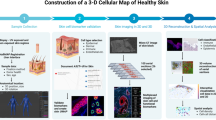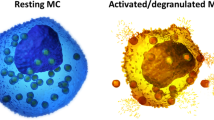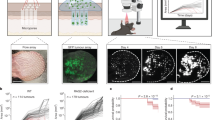Abstract
Human skin harbors various immune cells that are crucial for the control of injury and infection. However, the current understanding of immune cell function within viable human skin tissue is limited. We developed an ex vivo imaging approach in which fresh skin biopsies are mounted and then labeled with nanobodies or antibodies against cell surface markers on tissue-resident memory CD8+ T cells, other immune cells of interest, or extracellular tissue components. Subsequent longitudinal imaging allows one to describe the dynamic behavior of human skin-resident cells in situ. In addition, this strategy can be used to study immune cell function in murine skin. The ability to follow the spatiotemporal behavior of CD8+ T cells and other immune cells in skin, including their response to immune stimuli, provides a platform to investigate physiological immune cell behavior and immune cell behavior in skin diseases. The mounting, staining and imaging of skin samples requires ~1.5 d, and subsequent tracking analysis requires a minimum of 1 d. The optional production of fluorescently labeled nanobodies takes ~5 d.
This is a preview of subscription content, access via your institution
Access options
Access Nature and 54 other Nature Portfolio journals
Get Nature+, our best-value online-access subscription
$29.99 / 30 days
cancel any time
Subscribe to this journal
Receive 12 print issues and online access
$259.00 per year
only $21.58 per issue
Buy this article
- Purchase on Springer Link
- Instant access to full article PDF
Prices may be subject to local taxes which are calculated during checkout





Similar content being viewed by others
Data availability
Examples of the primary datasets underlying all data figures and Supplementary Videos presented in this article can be found at https://doi.org/10.5281/zenodo.3843094.
References
Kabashima, K., Honda, T., Ginhoux, F. & Egawa, G. The immunological anatomy of the skin. Nat. Rev. Immunol. 19, 19–30 (2019).
Pasparakis, M., Haase, I. & Nestle, F. O. Mechanisms regulating skin immunity and inflammation. Nat. Rev. Immunol. 14, 289–301 (2014).
Clark, R. A. Resident memory T cells in human health and disease. Sci. Transl. Med. 7, 269rv261 (2015).
Gebhardt, T., Palendira, U., Tscharke, D. C. & Bedoui, S. Tissue-resident memory T cells in tissue homeostasis, persistent infection, and cancer surveillance. Immunol. Rev. 283, 54–76 (2018).
Kumar, B. V. et al. Human tissue-resident memory t cells are defined by core transcriptional and functional signatures in lymphoid and mucosal sites. Cell Rep. 20, 2921–2934 (2017).
Steinert, E. M. et al. Quantifying memory CD8 T cells reveals regionalization of immunosurveillance. Cell 161, 737–749 (2015).
Mackay, L. K. et al. The developmental pathway for CD103(+)CD8+ tissue-resident memory T cells of skin. Nat. Immunol. 14, 1294–1301 (2013).
Skon, C. N. et al. Transcriptional downregulation of S1pr1 is required for the establishment of resident memory CD8+ T cells. Nat. Immunol. 14, 1285–1293 (2013).
Gebhardt, T. et al. Memory T cells in nonlymphoid tissue that provide enhanced local immunity during infection with herpes simplex virus. Nat. Immunol. 10, 524–530 (2009).
Ariotti, S. et al. T cell memory. Skin-resident memory CD8(+) T cells trigger a state of tissue-wide pathogen alert. Science 346, 101–105 (2014).
Clark, R. A. et al. Skin effector memory T cells do not recirculate and provide immune protection in alemtuzumab-treated CTCL patients. Sci. Transl. Med. 4, 117ra117 (2012).
Muruganandah, V., Sathkumara, H. D., Navarro, S. & Kupz, A. A systematic review: the role of resident memory T Cells in infectious diseases and their relevance for vaccine development. Front. Immunol. 9, 1574 (2018).
Edwards, J. et al. CD103(+) Tumor-resident CD8(+) T cells are associated with improved survival in immunotherapy-naive melanoma patients and expand significantly during anti-PD-1 treatment. Clin. Cancer Res. 24, 3036–3045 (2018).
Park, S. L., Gebhardt, T. & Mackay, L. K. Tissue-resident memory T cells in cancer immunosurveillance. Trends Immunol. 40, 735–747 (2019).
Cheuk, S. et al. CD49a expression defines tissue-resident CD8(+) T cells poised for cytotoxic function in human skin. Immunity 46, 287–300 (2017).
Solimani, F., Meier, K. & Ghoreschi, K. Emerging topical and systemic JAK inhibitors in dermatology. Front. Immunol. 10, 2847 (2019).
Ariotti, S. et al. Tissue-resident memory CD8+ T cells continuously patrol skin epithelia to quickly recognize local antigen. Proc. Natl Acad. Sci. USA 109, 19739–19744 (2012).
Gebhardt, T. et al. Different patterns of peripheral migration by memory CD4+ and CD8+ T cells. Nature 477, 216–219 (2011).
Li, J. L. et al. Intravital multiphoton imaging of immune responses in the mouse ear skin. Nat. Protoc. 7, 221–234 (2012).
Zaid, A. et al. Persistence of skin-resident memory T cells within an epidermal niche. Proc. Natl Acad. Sci. USA 111, 5307–5312 (2014).
Beura, L. K. et al. Normalizing the environment recapitulates adult human immune traits in laboratory mice. Nature 532, 512–516 (2016).
Dijkgraaf, F. E. et al. Tissue patrol by resident memory CD8(+) T cells in human skin. Nat. Immunol. 20, 756–764 (2019).
Wu, C. H. et al. Imaging cytometry of human leukocytes with third harmonic generation microscopy. Sci. Rep. 6, 37210 (2016).
Nishida-Aoki, N. & Gujral, T. S. Emerging approaches to study cell–cell interactions in tumor microenvironment. Oncotarget 10, 785–797 (2019).
Grivel, J. C. & Margolis, L. Use of human tissue explants to study human infectious agents. Nat. Protoc. 4, 256–269 (2009).
Kennedy, L. H. & Rinholm, J. E. Visualization and live imaging of oligodendrocyte organelles in organotypic brain slices using adeno-associated virus and confocal microscopy. J. Vis. Exp. 128, 56237 (2017).
Groff, B. D., Kinman, A. W. L., Woodroof, J. F. & Pompano, R. R. Immunofluorescence staining of live lymph node tissue slices. J. Immunol. Methods 464, 119–125 (2019).
Peranzoni, E. et al. Ex vivo imaging of resident CD8 T lymphocytes in human lung tumor slices using confocal microscopy. J. Vis. Exp., 2017, 55709 (2017).
Stucker, M. et al. The cutaneous uptake of atmospheric oxygen contributes significantly to the oxygen supply of human dermis and epidermis. J. Physiol. 538, 985–994 (2002).
Mort, R. L., Hay, L. & Jackson, I. J. Ex vivo live imaging of melanoblast migration in embryonic mouse skin. Pigment Cell Melanoma Res. 23, 299–301 (2010).
Weigelin, B., Bakker, G. J. & Friedl, P. Third harmonic generation microscopy of cells and tissue organization. J. Cell Sci. 129, 245–255 (2016).
Bins, A. D. et al. A rapid and potent DNA vaccination strategy defined by in vivo monitoring of antigen expression. Nat. Med. 11, 899–904 (2005).
Hsiao, C. Y. et al. Effects of different immersion media in multiphoton imaging of the epithelium and dermis of human skin. Microsc. Res. Tech. 69, 992–997 (2006).
Wei, S. H. et al. Ca2+ signals in CD4+ T cells during early contacts with antigen-bearing dendritic cells in lymph node. J. Immunol. 179, 1586–1594 (2007).
Platonova, E. et al. Single-molecule microscopy of molecules tagged with GFP or RFP derivatives in mammalian cells using nanobody binders. Methods 88, 89–97 (2015).
Gurskaya, N. G. et al. Engineering of a monomeric green-to-red photoactivatable fluorescent protein induced by blue light. Nat. Biotechnol. 24, 461–465 (2006).
Adachi, T. et al. Hair follicle-derived IL-7 and IL-15 mediate skin-resident memory T cell homeostasis and lymphoma. Nat. Med. 21, 1272–1279 (2015).
Yew, E., Rowlands, C. & So, P. T. Application of multiphoton microscopy in dermatological studies: a mini-review. J. Innov. Opt. Health Sci. 7, 1330010 (2014).
Clark, R. A. et al. The vast majority of CLA+ T cells are resident in normal skin. J. Immunol. 176, 4431–4439 (2006).
Firooz, A. et al. The influence of gender and age on the thickness and echo-density of skin. Skin Res. Technol. 23, 13–20 (2017).
Boehncke, W. H. & Schon, M. P. Psoriasis. Lancet 386, 983–994 (2015).
Watanabe, R. et al. Human skin is protected by four functionally and phenotypically discrete populations of resident and recirculating memory T cells. Sci. Transl. Med. 7, 279ra239 (2015).
Arbabi-Ghahroudi, M. Camelid single-domain antibodies: historical perspective and future outlook. Front. Immunol. 8, 1589 (2017).
Goedhart, M. et al. CXCR4, but not CXCR3, drives CD8+ T-cell entry into and migration through the murine bone marrow. Euro. J. Immunol. 49, 576–589 (2019).
Schindelin, J. et al. Fiji: an open-source platform for biological-image analysis. Nat. Methods 9, 676–682 (2012).
Khan, T. N., Mooster, J. L., Kilgore, A. M., Osborn, J. F. & Nolz, J. C. Local antigen in nonlymphoid tissue promotes resident memory CD8+ T cell formation during viral infection. J. Exp. Med. 213, 951–966 (2016).
Guimaraes, C. P. et al. Site-specific C-terminal and internal loop labeling of proteins using sortase-mediated reactions. Nat. Protoc. 8, 1787–1799 (2013).
Durand, R. E. & Olive, P. L. Cytotoxicity, mutagenicity and DNA damage by Hoechst 33342. J. Histochem. Cytochem. 30, 111–116 (1982).
Purschke, M., Rubio, N., Held, K. D. & Redmond, R. W. Phototoxicity of Hoechst 33342 in time-lapse fluorescence microscopy. Photochem. Photobiol. Sci. 9, 1634–1639 (2010).
Cahalan, M. D. & Parker, I. Choreography of cell motility and interaction dynamics imaged by two-photon microscopy in lymphoid organs. Annu. Rev. Immunol. 26, 585–626 (2008).
Beltman, J. B., Maree, A. F. & de Boer, R. J. Analysing immune cell migration. Nat. Rev. Immunol. 9, 789–798 (2009).
Acknowledgements
Plasmid sequences for anti-mouse and anti-human CD8 nanobodies were kindly provided by 121Bio with support of M. Gostissa and G. Grotenbreg (Agenus subsequently acquired substantially all the assets of 121Bio). We acknowledge H. Ploegh (Harvard University) for the sortase expression vector and H. Ovaa and D. El Atmioui (Leiden University) for providing the GGGC peptide. We thank T. Venema (Slotervaart Ziekenhuis), P.G.L. Koolen (Rode Kruis Ziekenhuis), and W.G. van Selms (Onze Lieve Vrouwe Gasthuis West) and staff of the plastic surgery departments for the human skin tissue. We thank J. Beltman (LUMC) and B. van den Broek (Netherlands Cancer Institute, NKI) for analysis of migration parameters, J. Song (NKI) for histopathological analysis, M. Hoekstra (NKI) for illustration of the ex vivo imaging setup, T. Rademakers (Maastricht University), M. Rashidian (Dana-Farber Cancer Institute), L. Oomen, and L. Brocks (NKI) for technical support, and L. Perie (Curie Institute) and members of the Schumacher and Haanen laboratories for discussions. This work was supported by ERC AdG Life-His-T (to T.N.S.) and an EADV Research Fellowship (to T.R.M.).
Author information
Authors and Affiliations
Contributions
F.E.D. and D.W.V. conceived the idea of the murine ex vivo imaging setup. F.E.D. designed and performed experiments with murine and human skin, and analyzed imaging data. M.T. generated nanobodies and nanobody conjugates. M.H. performed multiphoton imaging experiments. F.E.D. and M.M. designed imaging analysis. T.R.M. and M.B.M.T. organized human skin material. F.E.D., M.T., M.H., T.R.M., M.B.M.T., D.W.V., R.M.L., and T.N.S. contributed to protocol design. F.E.D. and T.N.S. wrote the manuscript with input from all co-authors.
Corresponding author
Ethics declarations
Competing interests
The authors declare no competing interests.
Additional information
Peer review information Nature Protocols thanks the anonymous reviewers for their contribution to the peer review of this work.
Publisher’s note Springer Nature remains neutral with regard to jurisdictional claims in published maps and institutional affiliations.
Related links
Key reference using this protocol
Dijkgraaf, F. et al. Nat. Immunol. 20, 756–764 (2019): https://doi.org/10.1038/s41590-019-0404-3
Supplementary information
Supplementary Video 1
CD8+ T cells in murine ex vivo skin regain motility and dendricity after overnight culture. Maximum confocal microscopy projection of OT-I GFP+ CD8+ T cells (green) in mouse skin imaged directly after mounting in ex vivo imaging setup. Cells start off round and immobile and regain mobility and dendricity over time (time in minutes). N=2 recordings and 2 independent observations. Scale bar, 50 μm.
Supplementary Video 2
Removal of sodium azide from conventional antibody reagent allows detection of migrating epidermal CD8+ CD103+ T cells in human skin. First segment: Section view of MP recording showing ex vivo human skin biopsy stained with anti-hCD103-AF488 conventional antibody (green) without removal of sodium azide, also showing anti-hCD8-AF594 nanobody staining and second harmonics generation signal (SHG, blue). Note that CD8+ T cells display a round morphology and are immobile. Representative of n=2 individuals. Scale bar, 20 μm. Second segment: Section view of MP recording showing ex vivo human skin biopsy stained with anti-hCD103-AF488 conventional antibody (green) after removal of sodium azide, also showing anti-hCD8-AF594 nanobody staining and second harmonics generation signal (SHG, blue). Note that CD8+ CD103+ T cells display a variable morphology and migrate. Data in second segment adapted from Supplementary Video 11 in 22. Representative of n=3 individuals. Scale bar, 15 μm.
Supplementary Video 3
Labeling and tracking of CD8+ T cells in ex vivo human skin. First segment: Top view of MP-recordings showing examples of tracked anti-hCD8-AF594 nanobody labeled T cells (red) that migrate in ex vivo human skin. Second segment: Examples of autofluorescent and fragmented AF594+ objects in ex vivo human skin biopsies stained with anti-hCD8-AF594 nanobody (red), also showing second harmonics generation signal (SHG, collagen type I, blue). Both segments: lines indicate tracked cells. Datasets are described in Fig. 4a in 22. Data representative of n=4 individuals. Scale bars, 10 μm.
Supplementary Video 4
Visualization of immune cells and structural components in ex vivo human skin using conventional staining reagents. First segment: Top view of MP-recording showing anti-hCD8-AF594 nanobody-labeled CD8+ T cell (red) migrating in between Hoechst+ nuclei (gray) in the epidermis. Dataset described in Supplementary Video 9-II in 22. Representative of n=4 individuals. Scale bar, 10 μm. Second segment: Section view showing anti-hCD8-AF594 nanobody-labeled CD8+ T cell (red) migrating below anti-hCD1a-AF488 antibody labeled Langerhans cells (green), also showing second harmonics generation signal (collagen type I, blue). Dataset described in Supplementary Video 12-I in 22. Representative of n=4 individuals. Scale bar, 50 μm. Third segment: Section view of MP-recording showing anti-hCD8-AF594 nanobody labeled CD8+ T cells (red) migrating alongside anti-human collagen type IV positive structures (i.e., basement membrane and dermal vessels, green), also showing second harmonics generation signal (collagen type I, blue). Dataset is described in Supplementary Video 14-II in 22. Representative of n=3 individuals. Scale bar, 20 μm.
Supplementary Data 1
DNA sequence of the empty pHEN6c expression vector containing the LPETGG (i.e., Sortag) and 6xHis (i.e., Histag) sequence and the NcoI and BstEII cloning sites, which can be used to insert the desired nanobody sequence.
Rights and permissions
About this article
Cite this article
Dijkgraaf, F.E., Toebes, M., Hoogenboezem, M. et al. Labeling and tracking of immune cells in ex vivo human skin. Nat Protoc 16, 791–811 (2021). https://doi.org/10.1038/s41596-020-00435-8
Received:
Accepted:
Published:
Issue Date:
DOI: https://doi.org/10.1038/s41596-020-00435-8
Comments
By submitting a comment you agree to abide by our Terms and Community Guidelines. If you find something abusive or that does not comply with our terms or guidelines please flag it as inappropriate.



